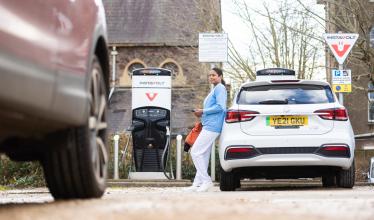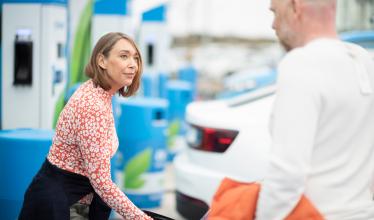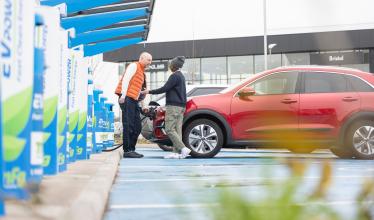Whether you've just got an electric car or are considering getting one, this guide is for you. Here we’ll walk you through some of the first steps of your adventure into electric travel.
The good news is that charging an electric vehicle can happen almost anywhere. What’s more, this guide is the best place to start if you’re after a few simple facts to get you on the road.
We’ve broken down some of the key information so you can get on with charging your electric car quickly and easily. Below you’ll see:
- Quick tips to help you start charging
- The types of places you can charge your car
- What all the power ratings mean
- Some of the best ways to charge your electric car
Charging an electric vehicle: Where do I start?

So once you’ve got your shiny new electric motor – now what? Well, your first step is to be intrigued, because the switch to electric transport is really exciting. We’ve not witnessed a shift as big as this since people started driving petrol-powered ‘autocars’ in the late 1800s.
So don’t worry if you find your first charging session a little daunting. But do spare a thought for petrol pioneer Henry Sturmey, who drove from John o’ Groats to Land’s End in 1897. He was almost barred entry to a ferry outside Plymouth because the skipper didn’t know what a car was. You shouldn’t have to worry about that now.
Indeed, there are now more than a million pure-electric cars across the UK, not to mention well over 76,000 public charge points and counting.
So where do I start?
Here are a few quick steps to tick off:
- Get a home charger if you can
- If not, don’t despair – there are loads of places you can charge
- Open the Zapmap app or desktop map
- Look at all the charge points in your area, or on your regular journeys
- Walk before you run – practice charging near home on networks you plan to use
- Enjoy the open road with absolutely no tailpipe emissions
You could also check out how to charge your electric car specifically in our range of model charging guides. These will help you understand your car’s charging times and connector types.
We recommend getting a home charger installed if you can because this is often the cheapest and most convenient way to charge your electric car.
Just imagine, you plug your car in when you get home from work and wake up the next morning to find it fully charged – often on the cheapest renewable electricity the grid has to offer.
Home charge points are compact devices usually fixed to your house or garage. They’re weatherproof, and either have a charging cable attached or a socket to plug in a portable cable. Find out more in our guide to electric car charging at home.

Charging at home is often the cheapest and most convenient way to charge your electric car.
Don’t worry if you can’t install a home charger. Plenty of drivers get along just fine without one, and there are loads of options available to you.
The UK’s public charging network is a great alternative for all of your charging needs, offering a range of charging speeds at varying prices. (There are even some free EV charging points you can use.)
If you haven’t already, download the Zapmap app to take a look at the charge points in your local area – you’ll likely be pleasantly surprised. Whether you’re on the open road, close to home or at your destination, you’ll be able to find all sorts of different charge points wherever you go.
You may find, for example, that you have dedicated on-street charging provision close to your home. This is a growing area of the UK’s public charging network, providing a solution for drivers who live in a flat or a house without off-street parking, and are therefore unable to charge their car at home.

Once you’ve taken a look at the charge points near you, think about your routine. How many miles do you drive each day, each week? What kind of long journeys do you do, if any?
At this point, says EV driver Maz Shar, you can start to look into the logistics in more detail: “Can you charge at your workplace? Can you charge while doing your weekly shop? While at the gym? Is there a charger within walking distance?
“Think about how long you normally spend there. If it’s an hour, it’ll be ideal to have a rapid charger – this is often the case at supermarkets and gyms. If it’s a few hours then a destination charger will suffice.”
Where can I charge my electric car?
There are all sorts of places you’ll come across charge points, whether you’re travelling for two minutes or two hours.
In fact, there are so many different charging locations that we’ve created a whole set of filters in the Zapmap app to help you narrow down your choices. This enables you to find available chargers that suit your needs by filtering for charge point network, location type, payment method, power type and more.
As you may know, you can charge an electric car at many different speeds (we’ll come to this in a bit). This means there are a few types of charging provision across the public network.
Broadly speaking, you can divide the public charging network into three:
- En-route charging points for longer journeys
- Destination charging for topping up the battery while you’re doing something else
- On-street charging, which provides local options for electric car drivers unable to charge at home
The speed at which you want to charge will influence which of these three types of charge point you choose.
For example, you tend to find the very quickest chargers at motorway service stations. These charge points are a great example of en-route charging provision, designed for drivers looking to recharge as quickly as possible on longer journeys. Find out more in the guides below.
What are the different connectors?
A few years ago, navigating the UK’s public charging network certainly came with some complexity. However, the public network has come on leaps and bounds over the past few years. The general trend is a very positive one, heading towards greater ease of use and a better user experience.
In part, this is thanks to standardisation of connector types. Type 2 and CCS connectors have almost become the standard connectors for electric vehicles (although Nissan is an exception). This has made finding compatible charge points significantly easier for drivers.
The main connector for lower-powered AC charging is Type 2, although you may also come across Type 1 and Industrial Commando connector types.
The main connector type for higher-powered DC charging is CCS (Combined Charging System), although some electric vehicles use CHAdeMO, while Teslas have their own proprietary Supercharger connectors.
What do the power ratings mean for my electric car?

When it comes to the speed at which your car can charge, generally speaking there are two broad categories of charge points to be aware of when using the public network.
But first, here’s a quick cheat sheet:

- High-power chargers
- Low-power chargers
Let’s take a look at these in a little more detail.
High-power chargers: 50-400 kW
These charging devices encompass both ‘rapid’ and ‘ultra-rapid’ chargers, as you’ll hear them called. They’re designed to increase your car’s range as quickly as possible, getting you back on the road again in no time.
With the quickest ones you’ll have enough time for a short coffee break, while others are useful either to top up the battery or to charge up fully over lunch when en-route to your destination.
Low-power chargers: 3-49 kW
The quicker devices within this banding are useful when you’re leaving the car behind for a few hours. This might be a day trip with the family, maybe you’re running errands – or perhaps you have a business meeting in the city.
At the other end of the spectrum, you’ll find some of the lowest-powered charge points integrated into lampposts and bollards on residential streets, or at places like hotels – anywhere you might leave your car parked for a long period of time. If you have a home charger installed, it’ll be within this range too. Because these particular chargers are designed for long stays or for overnight charging, at this speed your car will take anywhere from six to 18 hours to charge to 80%. (Although there are a few factors at play here, this essentially boils down to the capacity of the battery.)
Charging an electric vehicle: Best practice

These days charging your car is, for the most part, fairly intuitive. But there are definitely some tips and tricks to be aware of that will help you optimise your charging experience and make the most of your new electric lifestyle.
For starters, it’s best practice to top up your car before it drops below 20% charge. This is primarily for the health of the battery, but also for your own peace of mind. It’s good to have this 20% in reserve because you never know – there might be a diversion waiting for you just around the corner.
At the other end of the spectrum, it’s best to end your charging sessions once you reach 80%. From this point on, in order to protect the battery, it takes a lot longer to charge. In some cases, it can take as long to charge from 80-100% as it does from 20% to 80%.
How do I find EV chargers?
There are tens of thousands of public charge points across the UK, and this number is growing all the time. You may have seen signs on the motorway for en-route charging networks such as GRIDSERVE. You’ve probably walked past charge points at your local supermarket. Whether you’re on the open road, close to home or at your destination, you’ll be able to find all sorts of different chargers wherever you go.
However, by far the most reliable way to locate charge points that suit your needs is to open the Zapmap app. With almost all public charge points mapped, it gives you the widest choice of charging options, tailored to your needs. You can also see the current status of each location, so you know which chargers are available right now.
“I've had my electric car for four years and would never even think about going back to petrol,” says Senior Project Manager Eleanor Field.
“When I'm looking for charging locations, I use the Zapmap app with its handy filtering of location types. If I select ‘Supermarket,’ I can fit in a shop while I'm waiting for the car to charge. Very convenient!”

How do I pay for EV charging?
Ways to pay for charging vary, but the majority of charge point operators offer contactless payments via credit/debit card on the device itself, or alternative payment methods such as a network-specific app or RFID card.
The majority of rapid and ultra-rapid charge points now offer contactless payment. Quick, easy and accessible, contactless suits many people. The government has mandated that contactless payment be available on all new rapid chargers that are installed, and within the next couple of years this will also apply to any existing rapid chargers without contactless capability.
A simple way to pay for electric car charging across many networks is from within the Zapmap app.
Zap-Pay is a cross-network payment solution that allows you to start charging at the click of a button, and pay via credit/debit card, Apple Pay or Google Pay. You’ll want to select the charger you'd like to use within the app – a helpful Zap-Pay button will then pop up in a banner.

Once you’re charging, you can use the app to check the status of the charge at any time, including the estimated cost and the charge time remaining.
Which charge point networks should I use to charge my electric vehicle?
The UK’s public charging network has come on leaps and bounds over the past few years. The general trend is a positive one, heading towards greater ease of use and a better user experience.
As you may know, there are quite a number of EV charging networks across the country. Some are brand new and others well established, with many networks offering national coverage while others provide charging in a specific region.
Some networks are certainly doing a better job than others. Osprey Charging is a great example of an operator that’s prioritising accessibility, providing wider and longer bays for better access, and charge points designed to be used easily with just one hand.

When it comes to giving drivers protection from the elements, Fastned leads the pack. Many of Fastned’s charging hubs have a distinctive yellow canopy, which mirrors the protection offered at petrol stations and provides a safe, well-lit charging experience.
You can see which operators Zapmap users rated most highly in our yearly network rankings.
Charging an electric vehicle: Next steps
We hope the information so far has been helpful – and that you now feel intrigued. What’s above should serve as a solid foundation you can build upon.
And remember, this is just the beginning of your journey, so don’t be afraid to reach out to fellow drivers for tips and advice. There’s a thriving community of electric car drivers in the EV Café on the Zapmap app. They’ll be eager to share their experiences with you and keen to lend a helping hand if ever you need one.
Plus we have loads more guides you can explore, as well as market news, stats and tools to keep you informed and entertained.
But if you need one final push out the door, here’s our Co-Founder Melanie Shufflebotham sharing her thoughts on making the switch to an electric car all those years ago:
“I’ve been driving electric for over nine years. My initial motivation was the positive environmental benefits, but I could never go back now because I'm wedded to the smooth drive and simplicity of the automatic transmission - just press and go!”
With that, we wish you all the best on your electric road trips – and happy charging!








